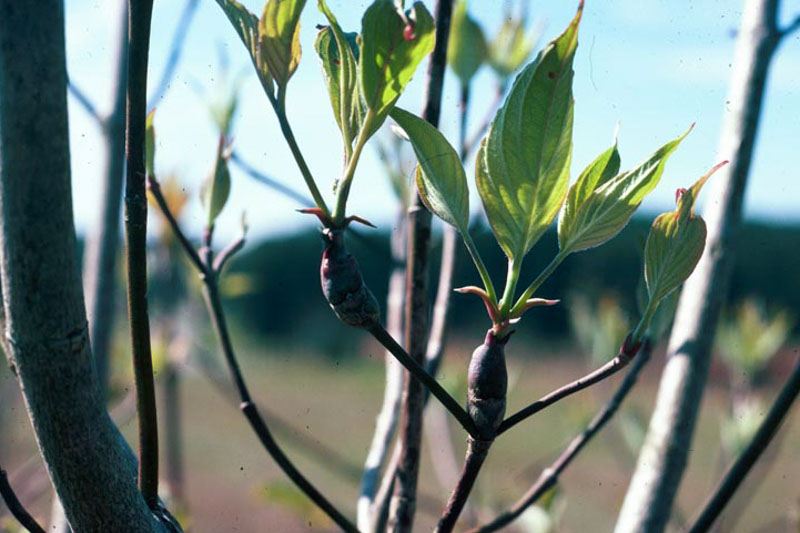The Dogwood Clubgall Midge (Resseliella clavula) is a tiny fly that causes distinctive galls to form on dogwood leaves.
The Dogwood Clubgall Midge (Resseliella clavula) is a small fly targeting dogwood trees, causing abnormal gall formations on leaves and stems.
The primary host plants for the Dogwood Clubgall Midge are various species of dogwood trees.
The Dogwood Clubgall Midge is primarily found in the eastern and central regions of North America, from Canada down to the southern United States. The distribution closely corresponds to the natural habitat of its primary host plants, the dogwood trees.
The adult midge is roughly 1/16 inch in size, featuring a vivid orange abdomen and a more subdued yellow-orange thorax. Its wings display a patchwork of black and yellow hairs, sometimes appearing as uneven bands. While the male’s antennae are as long as its body and segmented like beads, the female’s antennae are shorter and less ornate. The larva takes the form of an orange-hued maggot.

The life cycle of the Dogwood Clubgall Midge is somewhat unique among gall-forming insects.
The gall itself eventually dries out and may fall off the tree or remain attached. There can be multiple generations of Dogwood Clubgall Midges in a single growing season, depending on the climate and conditions.

Damage caused by the Dogwood Clubgall Midge is most often seen in the form of abnormal swellings, or galls, on the leaves and stems of dogwood trees. These galls are generally elongated and can vary in size. They can cause aesthetic damage to the tree but are usually not harmful to the overall health of mature trees. However, on young or stressed trees, a severe infestation can be more damaging.
Detection involves closely inspecting the young shoots and leaves of your dogwood trees, particularly during late spring when new growth occurs. Look for the characteristic galls and observe any larvae or adult midges around the tree.
The best time for inspection is late summer to early fall when galls are mature and before larvae have exited to overwinter. If you see these signs, it’s likely that your dogwood tree is hosting a Dogwood Clubgall Midge infestation.
Once galls are present, it’s likely too late to eliminate the internal midge larvae using pesticides. However, a contact pesticide can be effectively applied when leaf buds are just beginning to open to manage the Dogwood Clubgall Midge. After gall formation, pruning remains the most viable control option.
Create a membership account to save your garden designs and to view them on any device.
Becoming a contributing member of Gardenia is easy and can be done in just a few minutes. If you provide us with your name, email address and the payment of a modest $25 annual membership fee, you will become a full member, enabling you to design and save up to 25 of your garden design ideas.
Join now and start creating your dream garden!
Create a membership account to save your garden designs and to view them on any device.
Becoming a contributing member of Gardenia is easy and can be done in just a few minutes. If you provide us with your name, email address and the payment of a modest $25 annual membership fee, you will become a full member, enabling you to design and save up to 25 of your garden design ideas.
Join now and start creating your dream garden!